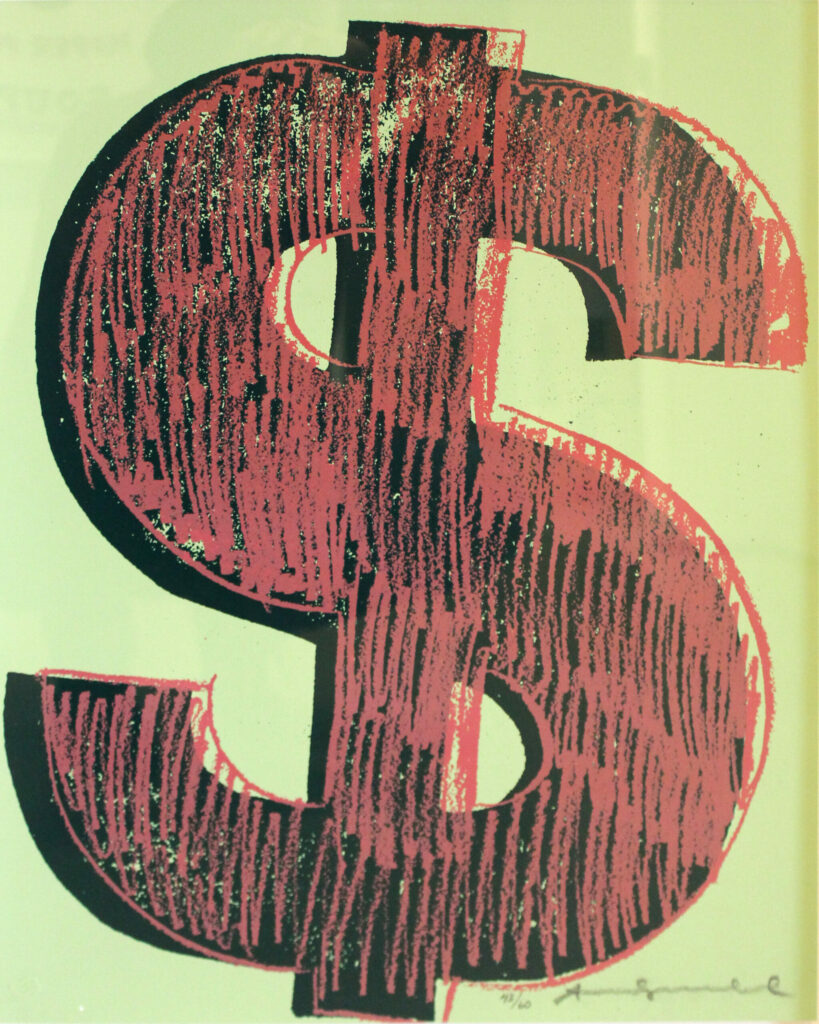
Dollar Sign 274 is a one of six screenprints from Andy Warhol‘s 1982 series titled Dollar Sign, or “$”. Other prints in the series include the dollar sign in various colorations, like Dollar Sign 279 and 280. Other iterations of the Dollar Sign schema can be seen in Dollar Sign (Quadrant) and Dollar Sign (9), completed in the same year.
Andy Warhol loved money, and he reveled in painting the things he loved. In a way, the dollar sign symbol was a fated subject for the Pop artist to undertake. “I like money on the wall,” Warhol commented in his 1975 book, The Philosophy of Andy Warhol. “Say you were going to buy a $200,000 painting. I think you should take that money, tie it up, and hang it on the wall. Then when someone visited you the first thing they would see is money on the wall.” The dollar sign symbol is a Pop image through and through. In Dollar Sign 274, Warhol places capitalism at the forefront of modern art, observing how intertwined the two worlds are.
Dollar Sign 274 displays the subject in complementary colors, the dark symbol dusted with weathered texture and a deep red scrawl. Warhol created the symbol himself rather than using a photograph, which was a rare choice for him. As with many of the works in this portfolio, Dollar Sign 274 underscores its man-made components. Whether through scribbled sketches or painted signage, Warhol insinuates that the idea of money is an American commodity itself. In fact, the work implies that human hands are in constant contact with commerce in some shape or form. No matter if we are buying or selling, designing advertisements or glancing at them, we are always interacting with consumer culture.
The Pop Art movement shattered the barrier between high and low art. As Warhol said, “the Pop artists did images that anybody walking down Broadway could recognize in a split second—comics, picnic tables, men’s trousers, celebrities, shower curtains, refrigerators, Coke bottles—all the great modern things that the Abstract Expressionists tried so hard not to notice at all.” Pop Art was also about leaving things as they were, presenting them the way they existed in the real world. Consumer culture and currency were not often the subjects of modern art. Warhol made a momentous statement, then, by placing dollar signs on canvas. Something so significant to our culture deserved its place in art. Money reigned supreme in its sway over culture, and Warhol was not afraid to voice the truth. In addition, the world and its functions had changed. It was no longer based in agriculture, but industry and manufacturing.
Warhol saw a modern society before him, one dominated by the repetition of factory production and the almighty dollar. He wanted to portray the immensity and singularity of consumerism because that was what he saw around him. From the time he first began doing commercial art, he took notice of the way people interacted with products and advertisements. Americans loved to spend money and Warhol didn’t consider himself above consumer culture. He was an active part of it and often said he loved shopping himself, especially on Saturdays.
Dollar Sign 274 represents a subject Warhol loved most. Through placing the dollar sign front and center, he emboldens the viewer to confront its inescapable relation to both the art world and our daily lives.
Courtesy of Revolver Gallery, West Holywood, California
